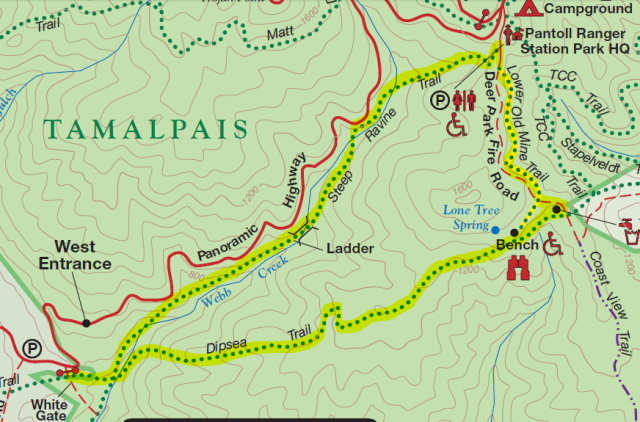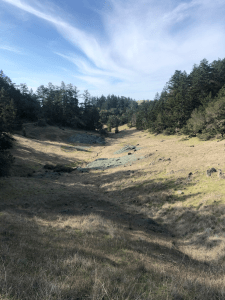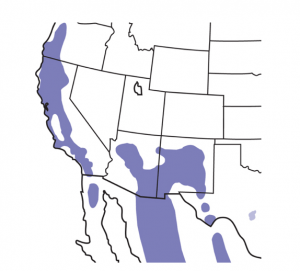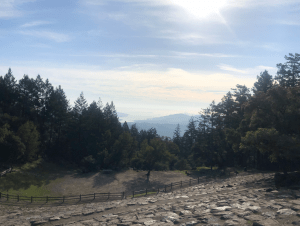Date: February 20th, 2020 – https://ebird.org/checklist/S64792314
Location: Mount Tamalpais State Park – 37.889, -122.611 – Elevation: 784m/2,572ft
Site Description: We hiked for around 2.5 hours along the trails through Mount Tamalpais State Park. Mount Tamalpais is located in the center of Marin County and has varied vegetation ranging from tall conifer trees to small, dry shrubbery. The bird populations present in the park are sometimes difficult to locate because the trails are heavily wooded. The topography was largely hilly and varied and with some stretches of open pastures along the trails.¹ Grasses and small bushes could be easily seen along the sides of the trails, but we did not find many bird species in this shrubbery like we usually do. The key bird species we saw were Dark-eyed Juncos, Chestnut-backed Chickadees, and many Acorn Woodpeckers. We saw several Acorn Woodpeckers flying amongst tall conifer trees when we entered the amphitheater area. Along our hike we also saw many Band-tailed Pigeons, California Scrub-Jays, and Common Ravens. Near the end of the hike, we saw one Red-tailed Hawk. We were surprised that we did not see any Turkey Vultures or Ravens on this particular day. Although we could hear many birds throughout the morning, they were often difficult to identify because they were far away and their calls could not be distinguished. Further, we believe that the wooded nature of the park prevented us from seeing many bird species even when they may have been close by. This site was the best yet for seeing woodpeckers.
Species Account: Acorn Woodpecker – Melanerpes formicivorus (Piciformes > Picidae) The Acorn Woodpecker is a medium-sized woodpecker with a unique face pattern including a distinctive red crown, yellowish forehead and throat, and pale eyes. Most of their body is a glossy black color with a streaky white and black chest region. They have a medium-sized black bill to match their back color.² Males and females look alike but females are often slightly larger and more round than males. The Acorn WoodpeckerCan be found in mixed conifer forests where they have tall trees to fly amongst. They are typically found in large groups and one of their behaviors is hiding acorns in the holes of trees (hence the name Acorn Woodpecker). They exhibit cooperative breeding. They nest in the cavities of tall trees. Acorn woodpeckers are often found along the West Coast of the United States in states such as California, Oregon, and Washington as well as Arizona, New Mexico, Mexico, and through Central America and Colombia. We saw at least fifteen Acorn Woodpeckers flying between trees and expressing their vocalizations to one another. This species is omnivorous and consume largely acorns and insects, although they may feed on fruits, seeds, and sometimes the eggs of other birds.3 The many acorn woodpeckers that we saw on this Thursday morning were easily distinguished by their red crowns and distinct flying patterns among the trees. They were also very noisy and highly interactive with one another. Many of them would rest on fences and in open areas and we would get a nice view of the profile. We also saw them rest on the sides of wooden poles and sometimes upside down. It is believed, from observations about their behavior, that they were hiding acorns and other nuts in wooden posts and trees near the amphitheater area. The year round distribution of these birds can be found in the image below.
Narrative:We left the University of San Francisco around 8:15am on February 20th and arrived on site at Mount Tamalpais State Park at 9:10am. Throughout the almost three hours we spent there, we travelled along the trails and stop in various pockets of the park to observe bird species. We saw 8 different birds taxa over a span of 192 minutes and a distance of 17.28 miles as estimated by eBird. I enjoyed traveling to the State Park on such a nice and sunny day even though we did not have the change to see many bird species. I am hoping we are able to see more of the rare bird species in our future trips to Marin. Mount Tamalpais State Park was sunny with a high of 62° and a low of 47°.4 We left the State Park and traveled to another peak where we were for about 20 minutes without spotting any birds, then headed back to USF at 11:35 am and returned to the Koret Parking Lot at 12:20am.
Additional Photos & Media: See below photos for an image of the amphitheater where we saw many Acorn Woodpeckers and the second site we went to (a peak nearby) before heading back to USF.
Sources:
¹ “Dipsea Trail – Steep Ravine Trail Loop (Mount Tamalpais State Park, CA).” Live and Let Hike, 15 Jan. 2020, liveandlethike.com/2015/04/22/dipsea-trail-steep-ravine-trail-loop-mount-tamalpais-state-park-ca/.
² “Acorn Woodpecker.” eBird, The Cornell Lab, https://ebird.org/species/acowoo.
3 “Acorn Woodpecker.” Audubon, 11 Oct. 2019, www.audubon.org/field-guide/bird/acorn-woodpecker.
4 Yu Media Group. “Mount Tamalpais State Park, CA – Detailed Weather Forecast, Long Range Monthly Outlook and Climate Information.” Weather Atlas, www.weather-us.com/en/california-usa/mount-tamalpais-state-park.








